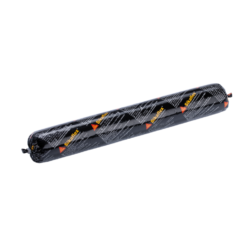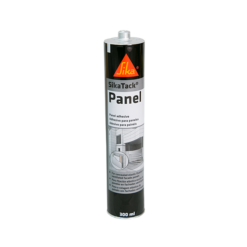Sikatack Panel Adhesive Sausage 600cc (24107) – 20pcs/box
£745.00 +VAT
Price for 1 box (contains 20pcs)
Unit : 1 box
Price for 1 piece: £37.25
SikaTack® Panel is a paste-like, 1-component polyurethane that doesn’t sag and is suitable for structural joints in ventilated facades and interior wall cladding. It is used to bond the panel to the vertically installed substructure where high dynamic and static stresses are expected. SikaTack® Panel cures when exposed to atmospheric humidity. It is a crucial component of the SikaTack® Panel system, which provides a hidden and cost-effective way to fix ventilated facades.
PRODUCT BENEFITS
- Elastic fixing system, vibration and movement absorbing
- SikaTack® Panel is approved from “Deutsches Institut für Bautechnik, DIBT”
- Provides creative opportunities for facade design
- Uniform tension over the whole facade
panel (no stress points) - Withstands high dynamic and static stresses
- 1-part product, ready to use
- Weathering resistant
- Bonds well to a wide variety of substrates
Usage
SikaTack® Panel is appropriate for structural joints in ventilated facades and interior wall cladding between the vertically installed substructure and the facade panel which are expected to undergo dynamic and static stresses. It can be used on anodized and coated aluminium, metal composite, high-pressure laminate, and ceramic materials. This product should only be used by experienced professionals, and actual substrate tests must be conducted to ensure adhesion and material compatibility.
Typical Product Data
| Chemical base | 1-component polyurethane | |
| Colour (CQP001-1) | Ivory | |
| Cure mechanism | Moisture-curing | |
| Density (uncured) | 1.1 kg/l
|
|
| Non-sag properties | Good | |
| Application temperature | ambient
|
5 ─ 40 °C
|
| Skin time (CQP019-1) | 35 minutes A | |
| Curing speed (CQP049-1) | (See diagram)
|
|
| Shore A hardness (CQP023-1 / ISO 48-4) | 45 | |
| Tensile strength (CQP036-1 / ISO 527) | 2.5 MPa | |
| Elongation at break (CQP036-1 / ISO 527) | 500 % | |
| Tear propagation resistance (CQP045-1 / ISO 34) | 7 N/mm | |
| Service temperature (CQP509-1 / CQP513-1) | -40 ─ 90 °C | |
| Shelf life | 12 months B |
| CQP = Corporate Quality Procedure | A) 23 °C / 50 % r. h. | B) storage below 25 °C |
Application Information
Surface Preparation
Surfaces must be clean, dry and free from grease, oil, dust and contaminants. Surface treatment depends on the specific nature of the substrates and is crucial for a long lasting bond.
Application
The standard geometry for bonding façade panels is at least 12 x 3 mm. The supplied nozzle (10 x 8 mm) ensures proper dimension of the compressed bead (see figure below).

For the best results, the substrate and adhesive should be applied at temperatures between 15 °C and 25 °C. It’s not recommended to apply the adhesive at temperatures lower than 5 °C or higher than 40 °C. To prevent condensation on the surfaces, the bonding components’ temperature, such as the façade panels and sub-frames, should be at least 3 °C higher than the dew point of the air. In hot and humid climates, the skin time is shorter, and the panel must be installed within 75% of the skin time determined under local climate conditions (see General Guideline “SikaTack® Panel System”). It’s important never to join bonding parts if the adhesive has built a skin. SikaTack® Panel can be applied using hand, pneumatic, or electric-driven piston guns.
Removal
To clean tools and equipment, SikaTack® Panel can be removed using Sika® Remover-208 or a compatible solvent before it cures. Once the adhesive has cured, it can only be removed through mechanical means.
After working with the product, washing your hands and any exposed skin immediately using hand wipes like Sika® Cleaner-350H or an appropriate industrial hand cleaner with water is important. Avoid using solvents on your skin.
Application Limits
SikaTack® Panel is used for panel bonding together with SikaTack® Panel Fixing Tape, which serves to keep the panels in place initially and ensure the correct joint thickness. As the SikaTack® Panel cures, it gradually builds up strength and assumes the long-term load-bearing role. However, it is important to note that SikaTack® Panel Fixing Tape is not a structural component.
| Weight | 0.65 kg |
|---|---|
| Size | JT4 4 4.8 X 19 S 14 (Ejot), JT4 4 4.8 X 19mm |
Related products
Sika Products
Sika Products
Sika Products
Sika Products
Sika Products
Sika Products
Sika Products











